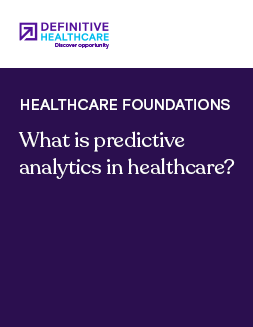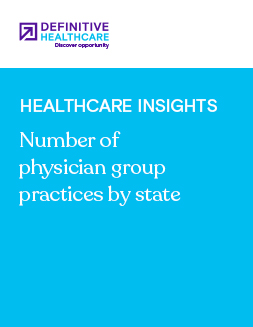Healthcare Insights
Top IDNs by average daily census
Integrated delivery networks (IDNs) have become a dominant force in the U.S. healthcare landscape. These comprehensive healthcare systems offer a one-stop shop for patients, providing a range of services from primary care to complex specialty treatments like heart transplants. This article dives into the top 20 IDNs in the U.S. based on their average daily census – a key metric reflecting patient volume and overall activity.
What is the average daily census?
The average daily census (ADC) refers to the average number of patients occupying beds on a given day over a specific period, typically a month or a year. It excludes newborns. This data provides valuable insights into a facility's patient volume, resource allocation, and overall activity.
Average daily census can vary significantly depending on factors such as the size of the hospital or IDN, the types of services provided, the population served, and seasonal fluctuations in patient volumes. In general, larger hospitals and IDNs tend to have higher ADCs due to their capacity to serve more patients.
Average daily census is just one metric used to evaluate patient volume and overall activity within a hospital or IDN. Other hospital metrics, such as total admissions, inpatient discharges, and outpatient visits, also contribute to understanding a health system’s utilization and performance.
What is the average daily census for a patient unit?
Average daily census is typically calculated for a hospital or health system as a whole. However, calculating the average daily census for a patient unit within a hospital or IDN can be helpful, especially in larger health systems or those with multiple specialized units. Monitoring daily census for individual units can assess staffing needs and bed availability within a unit.
The average daily census for a patient care unit can also vary depending on several factors:
- Unit type: A cardiac ICU will likely have a lower ADC compared to a medical-surgical unit.
- Hospital size and location: Larger hospitals and those in densely populated areas might have a higher ADC.
- Patient acuity: Units caring for critically ill patients will have a lower ADC as lengths of stay tend to be shorter.
Why is the average daily census important?
Average daily census is crucial for understanding the volume of patients being cared for and can provide insights into resource allocation, staffing needs, bed utilization, and overall capacity management. Hospitals and health systems use ADC to:
- Track capacity and resource allocation: A high ADC indicates the hospital is nearing full capacity, requiring adjustments in staffing or bed availability.
- Identify busy and slow periods: Understanding seasonal or cyclical trends in admissions helps with scheduling and resource allocation.
- Measure performance: ADC helps assess a hospital's efficiency in managing patient flow and bed occupancy.
- Make financial decisions: Hospitals rely on patient volume for revenue. ADC helps with budgeting and planning.
Overall, this metric is essential for hospital administrators and healthcare planners to monitor trends, forecast future demand for services, and make informed decisions regarding resource allocation and capacity planning to ensure efficient and effective patient care delivery. It also empowers companies selling into healthcare to identify high-volume facilities, predict trends, and inform targeting strategies.
| Rank | IDN | # of hospitals | Net patient revenue | Average daily census | Explore dataset |
|---|---|---|---|---|---|
| 1 | HCA Healthcare | 220 | $50.46 B | 25,582.4 | Explore |
| 2 | Universal Health Services | 182 | $10.39 B | 13,991.2 | Explore |
| 3 | CommonSpirit Health | 157 | $30.63 B | 10,607.3 | Explore |
| 4 | Ascension Health | 128 | $22.20 B | 9,535.2 | Explore |
| 5 | Trinity Health | 110 | $21.44 B | 8,726.8 | Explore |
| 6 | Advocate Health | 69 | $20.12 B | 7,735.8 | Explore |
| 7 | Encompass Health Corporation | 164 | $4.08 B | 6,931.0 | Explore |
| 8 | Tenet Healthcare | 83 | $14.02 B | 6,726.2 | Explore |
| 9 | Providence St Joseph Health | 57 | $17.61 B | 6,218.2 | Explore |
| 10 | AdventHealth | 53 | $12.83 B | 5,643.1 | Explore |
| 11 | Kaiser Permanente | 44 | $22.11 B | 5,228.2 | Explore |
| 12 | Community Health Systems | 79 | $10.64 B | 4,768.6 | Explore |
| 13 | Select Medical Corporation | 121 | $2.94 B | 4,030.8 | Explore |
| 14 | University of Pittsburgh Medical Center | 35 | $10.14 B | 3,764.6 | Explore |
| 15 | Northwell Health | 20 | $10.92 B | 3,698.2 | Explore |
| 16 | Bon Secours Mercy Health | 41 | $8.83 B | 3,650.9 | Explore |
| 17 | NewYork-Presbyterian Healthcare System | 13 | $10.23 B | 3,590.8 | Explore |
| 18 | LifePoint Health | 91 | $7.25 B | 3,587.3 | Explore |
| 19 | Cleveland Clinic Health System | 25 | $11.71 B | 3,548.6 | Explore |
| 20 | Banner Health | 35 | $10.02 B | 3,495.0 | Explore |
Fig. 1 Data is from our HospitalView product. Data accessed March 2024.
What is the largest IDN in the U.S.?
When evaluating the size of an IDN, several key metrics should be considered:
- Total facility area: Facility area is a measurement of the size of a healthcare facility, indicating the number of square feet in an organization’s fixtures and facilities.
- Geographic coverage: This refers to the geographical area covered by the IDN, which may include multiple states or regions.
- Net patient revenue (NPR): The total revenue generated by providing patient care services, after deducting discounts, contractual allowances, and charity care, which can provide insight into its financial strength.
- Number of beds: Staffed bed counts indicate the IDN's capacity to provide inpatient care and accommodate patients requiring hospitalization.
- Number of hospitals: The number of hospitals owned or operated by the IDN, which reflects the network's reach.
- Number of facilities: This includes hospitals, clinics, outpatient centers, and other healthcare facilities owned or operated by the IDN.
- Number of discharges: The number of inpatient discharges within the IDN's facilities, indicating the volume of healthcare services provided.
- Operating expenses (OPEX): The costs incurred in the day-to-day operations of the facility, excluding capital expenditures (CAPEX) for long-term investments such as building construction or major equipment purchases.
These metrics collectively provide a comprehensive overview of the size, scope, and capabilities of an IDN. Depending on which of these criteria is prioritized, different health systems may be considered the largest IDN in the U.S.
Learn more
Healthcare Insights are developed with healthcare commercial intelligence from the Definitive Healthcare platform. Knowing hospital size and scope metrics can help identify the right opportunities to target when selling to health systems and IDNs. Want even more insights? Start a free trial now and get access to the latest healthcare commercial intelligence on hospitals, physicians, and other healthcare providers.



